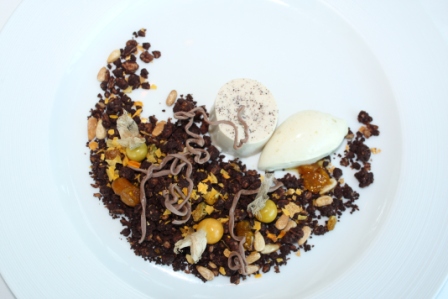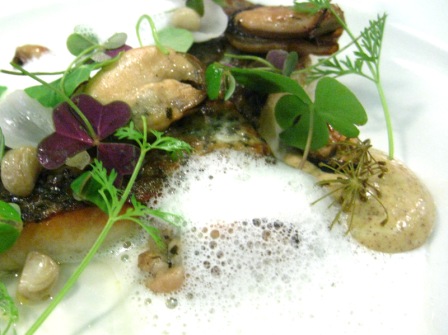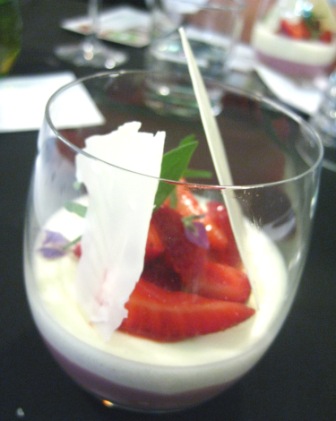Eating sustainable seafood
Posted: June 27, 2012 Filed under: Uncategorized | Tags: Cape Town, Restaurants, SASSI, Societi Bistro, Sustainable Seafood, The Greenhouse 1 CommentIf you didn’t catch my article, Do you eat sustainable seafood? yesterday on Food24, you can check it out below. (I’d love to hear your thoughts or comments on the issue!)
Eating at restaurants has to rank as one of my favourite activities, and my go-to main course is most often fish. But I’m beginning to get a little confuzzled with all the talk about SASSI ‘lists’.
What can or can’t I eat? How was it caught? Is it local?! Gosh, I start to feel overwhelmed just thinking about it. What about you?
What is SASSI?
‘SASSI was started in 2004 to bring awareness to the Marine Living Resources Act’, says Janine Basson, manager of seafood consumer outreach at SASSI.
Green list: You’re in the clear. This is the most sustainable choice – think angelfish, dorado, snoek, hake, mackerel, and Alaskan salmon.
Orange list: You may want to think twice here. Concerns are raised either due to overfishing or because the fishing or farming method causes harm to the environment. It includes sole, swordfish, prawns and abalone.
Red list: Stop! Don’t eat. The list includes unsustainable species and many are illegal to sell in South Africa – such as steenbras, musselcracker and river snapper.
‘The Orange list is the most complicated because it’s tied to many ecological issues’, explains Basson. Kingklip is one such example from the list. Why then do restaurants still offer it?
‘I think the main reason restaurants sell Orange listed fish is because it’s easier to find a variety of Orange list species’, says Cape Town seafood supplier, Julie Carter of Oceans Jewel Fish. ‘I can get Kingklip any day of the week’.
This may be true but it does create a great deal of confusion in the minds of consumers.
Restaurants
Cape Town chef, Stefan Marais of Societi Bistro, supports sustainable seafood and says there’s no set fish dish on any of his menus. ‘This allows us the opportunity to shop around for Green listed species. We have made a commitment to use only Green listed fish.’
Well-known independent restaurant critic JP Rossouw believes that restaurants will change their menus through consumer awareness and pressure to follow SASSI guidelines. ‘If they do promote SASSI this certainly positively influences my opinion’, he says. ‘It usually also means that the restaurant sources better ingredients in other areas too – as it shows a progressive approach.’
The Greenhouse (Eat Out restaurant of the year), offers a 6-course seafood menu featuring, amongst others, sustainably farmed Kabeljou. ‘Another great fish is mackerel’, says Executive chef, Peter Tempelhoff, who supports SASSI wholeheartedly. ‘It’s a wonderful fish to grill or lightly salt then pickle in rice vinegar for an hour… awesome for sushi or sashimi.’ Tempelhoff says that chefs and restaurateurs can play a big part in the fight against overfishing, but it has to be a collective voice.
The same goes for consumers such as Andy Fenner (Aka JamieWho) who points out, ‘The public need to be willing to try new species and also to ask questions about sustainability’.
Is there anything wrong with using good old hake? ‘For me it still remains an absolutely belting fish’, Andy says, and adds that he is a huge sucker for good sardines done simply with chilli oil and tons of garlic.
What you can do to support sustainable fishing
You need to ask questions:
1. What is it?
2. Where is it from?
3. How was it caught or farmed?
‘The consumer is the last word’, Rossouw says, ‘and therefore carries the most responsibility’.
Visit the SASSI mobi site – which allows you to access the SASSI seafood database from your phone, or use the FishMs by simply typing the name of the seafood species into a text message and send it to 079 499 8795. You’ll receive a response telling you what category the seafood falls into.
Image sourced here
Lunch at Waterkloof
Posted: May 7, 2012 Filed under: Restaurants | Tags: Biodynamic winemaking, SASSI, Sustainable Seafood, Waterkloof Restaurant 2 CommentsI was lucky enough to spend half a day in the winelands two weeks ago with three fellow journalists, learning about the sustainable practices at Waterkloof Restaurant and wine estate.
I’d never been to the estate before but after chatting with my editor about her own experience, it was inevitable that I began to create rather high expectations in my head. Well, it did not disappoint! In fact it far exceeded my expectations. All of them.
Waterkloof is situated in Somerset West, just off the Sir Lowry’s Pass Village Road and from the buildings’ extreme elevation overlooking False Bay, one really has to stop. Listen. Look. Breathe and take in the breathtaking surroundings. I now know what they mean when they describe it as ‘the vineyard in the sky’.
Gregory Czarnecki is the Chef de Cuisine and I met him for the first time towards the end of last year at the sustainable seafood dinner that was hosted by Wild Peacock in Stellenbosch. He’s extremely down-to-earth, exceptionally talented, incredibly French, and rather easy on the eye. As luck would have it- he’s also married.
Waterkloof is known for its biodynamic approach to viticulture which links with the notion of sustainability. It was evident, when chatting to Gregory, that he finds it a challenge to get hold of “basic” ingredients for his menu. Being French, he’s used to herbs that we don’t often have available here in South Africa (like French tarragon). So he tries to grow his own fresh stuff in a garden not far from the restaurant. There are also plans in place for a formal permaculture garden. So far it looks impressive.
The farm’s manager, Christian Loots was generous enough to take us on a guided tour and we were able to see just how effective a biodynamic viticultural practice is, where much insight and understanding is required into how the earth works in relation to the moon. Christiaan is a mindfield of information, leaving us with many “wow” moments.
Of course no man is an island, and so it makes sense that the restaurant follows this earthy and holistic approach. Gregory gets his eggs every day from the farm chickens. Not only are they guaranteed free-range, but he knows with absolute certainty that they are the freshest he will get. They made their way onto our plates in the form of a simple homey yet highly satisfying starter, executed to perfection.
In terms of seafood, the restaurant is SASSI approved, although our specific lunch menu featured orange-listed items; prawns and monkfish.
Menu
xxx
Sustainable Seafood with Wild Peacock and Oceanwise
Posted: October 24, 2011 Filed under: Rambles, Restaurants, Reviews, Uncategorized | Tags: Aquaculture, Dear Me, Eric Bulpitt, Fish Farming, Kabeljou, Oceanwise, SASSI, Sustainable Seafood, The Food Emporium, The Roundhouse, Valrhona, Vanessa Marx, Vanessa Quellec, Wild Peacock 3 CommentsMy first introduction to SASSI (South African Sustainable Seafood Initiative) came about five years ago when I was at ICA. During that stage, it was still fairly new and most people weren’t very aware of what it actually stood for. Little booklets then became available for people to check out what fish was on what list and whether or not their favourite restaurants were serving seafood on the ill-fated “red list”.
I’d say nowadays the awareness of eating sustainably is slowing gaining consciousness in the food industry-with a few restaurants leading the way in terms of educating their customers, while at the same time encouraging fellow establishments to become SASSI registered. Dear Me Foodworld in Cape Town’s Longmarket Street is one that has been classified as a SASSI “champion status” restaurant meaning they only serve seafood off the green list. Nowhere will you find prawns or even Kingklip on their menu. Another seafood eatery, The Brass Bell in Kalk Bay, has very cleverly printed SASSI-marked symbols next to each dish on the menu- which just shows the effort that they’re making to create awareness in the minds of their customers.
Obviously for a restaurant to take something like this seriously, a lot has to depend on suppliers. Wild Peacock and Ocean Jewels (both in the Western Cape) are two that deserve a good mention. I was privileged enough last week to be able to spend some time with the effervescent Julie from Ocean Jewels, as well as the team from Wild Peacock, at a dinner held in their beautiful Food Emporium in Stellenbosch. Wild Peacock is a supplier of sustainably farmed kabeljou which they source from OceanWise, a sustainable fish farm in East London, Eastern Cape. Go EC! My home province! (yeah, and all you thought we had was Oxbraai!!) . They are supported by Dear Me and The Roundhouse in Camps Bay (among others).
The evening was amazing with a 3 course dinner consisting of dishes prepared by Dear Me’s head chef Vanessa Marx, Eric Bulpitt from The Roundhouse and Miss Valrhona (aka talented pastry chef, Vanessa Quellec). The marketing guys from Oceanwise were there as well which made for a really worthwhile and informative evening. They had a small presentation with slides of what the fish farm actually looked like. Rather fascinating! All three of them were fantastic and were able to answer all of our questions while we gnawed away on their ethically farmed produce.
Wild Peacock have been supplying South Africa’s restaurant industry for over two decades with nothing but the best-quality ingredients and service, which makes them the ideal distributors of the sustainably farmed Kabeljou. They are however most well-known for their Saldanha Bay oysters which you’ll always find being offered to the public at prominent wine and food festivals:)
The Wild Peacock family really make the brand what it is- Sue together her son Ross run an amazing business, with daughter Sarah managing the Food Emporium.
Contact
Follow them on twitter: @WildPeacock, @SueBakerFood, @Food_Emporium
Or go to their website and check out the amazing products!
For information on Oceanwise, get hold of Liam Ryan: 082 771 9507
email: liam@espadonmarine.co.za
Did You Know?
– Kabeljou is also known as Dusky Kob
– The Australians call the fish `Mulloway’
– it takes 12 to 15 months for the fish to reach 1.5kg in weight
– The spawning cycle is managed by temperature and light control
– In South Africa wild Kob has to be 40cm by law.
– Oceanwise fish are over 40cm
– The Kob reach sexual maturity at approx 10kg and 10 years old
– 10 million eggs are produced per spawning female (usually spawn one female at a time)
– They only have a 50% hatchery rate
– Guy and Maryke Musson together with a small dedicated team from Oceanwise pioneered kabeljou farming in South Africa
– 10% of the water that is circulated and treated goes back into the ocean
xxx

















